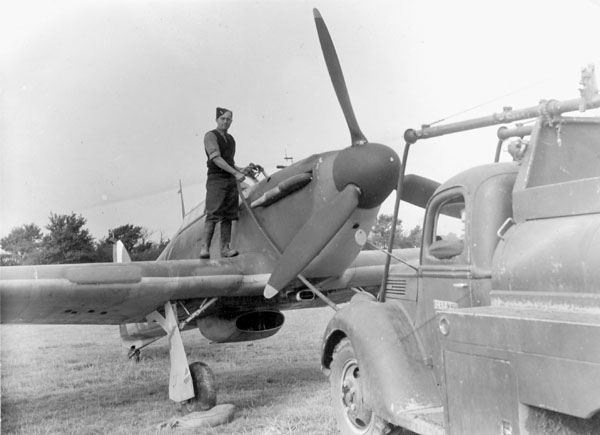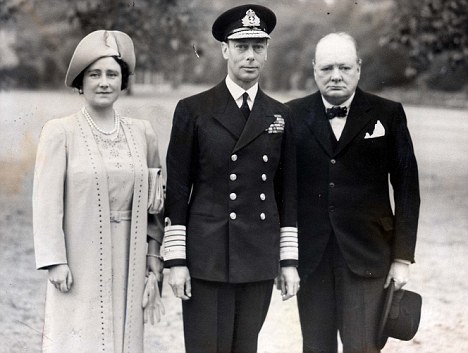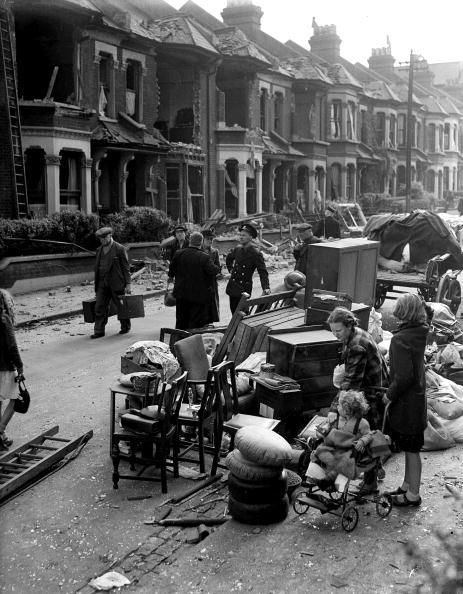Sunday 6 October 1940
 |
| The great Legionnaire (Iron Guard) manifestation in Bucharest, October 6,1940. |
Battle of Britain: The poor weather returns, with more clouds and rain over England. In fact, the Luftwaffe actually begins a large raid at one point, but it turns back due to the weather. Instead, the day is characterized by lone "pirate" raiders conducted by specially trained crews who make hit-and-run raids on selected targets.
Late in the morning, a raider bombs Middle Wallop, while at 12:45 it is the turn of RAF Biggin Hill. Another raid on Eastbourne damages gas/water lines.
The Luftwaffe attacks the same convoy at 13:30 and then again an hour later. This is the largest raid of the day, with maybe a dozen bombers, but it accomplishes nothing. At 16:19, a bomber from Chartres starts to come across but turns back. A little while later, a Junkers Ju 88 strafes RAF White Waltham and Farnborough, and a bomber scores some minor hits on the Hawker Aircraft Factory at Stough. Another strafing attack on RAF Northolt catches a Hurricane about to take off and destroys it and kills the pilot, while the Junkers Ju 88 is hunted down and destroyed at Leatherhead, Surrey. Other attacks during the afternoon take place at Biggin Hill and Croydon.
London does have a few minor attacks during the day, but after dark, everything is very quiet. An occasional bomber crosses over, such as one at 20:00 and another at 21:00, but they don't accomplish much. There are a couple of more lone raiders before midnight, then the remainder of the night is peaceful.
Overall, losses are in the single digits for both sides. The RAF loses two planes, and the Luftwaffe about nine.
 |
| An airman refueling a Hawker Hurricane I aircraft of No. 1 (F) Squadron, RCAF. Northolt, England, October 6, 1940. Photographer unknown. |
Sergeant Frederick Fenton Vinyard, flying a Spitfire for RAF No. 64 Squadron, has some kind of mechanical or weather issue and crashes into the sea near Beverley, Yorkshire. It is a typical incident, no glory, an accident, just another casualty of the war. However, sometimes we remember an individual now and then. His name is listed at the Air Forces Memorial, or Runnymede Memorial, in Englefield Green, near Egham, Surrey, England.
Hauptmann Helmut Wick receives the Oak Leaves for his 40th victory on the 5th.
Oblt. Werner Streib, Gruppenkommanduer of I./NJG 1 is awarded the Ritterkruez. He is instrumental in developing the Luftwaffe's night fighter force.
Perhaps the biggest news of the day is that the Luftwaffe has a new version of the Bf 109 to play with. Geschwaderkommodore Werner Mölders of JG 51, the top scorer in the battle, is given the honor of being the first to fly the new Bf 109 F-1 WNr. 5628 'SG+GW' in action. The weather is so bad that he makes no interceptions.
European Air Operations: During the day, RAF Bomber Command bombs several ports along the Channel coast, including Boulogne, Calais, and Ostend. along with the airfield at Diepholz. Coastal Command attacks a German convoy off the Dutch coast and loses a Hudson.
 |
| HMS Poulmic. |
U-123 torpedoes and sinks 5943-ton British cargo ship Benlawers at 13:04. The Benlawers is loaded with trucks and other goods destined for British forces at Cairo. There are 27 survivors and 24 men perish. The Benlawers is a straggler from Convoy OB 221.
U-103 torpedoes and sinks 6123-ton Norwegian tanker Nina Borthen in the same general area as U-123's success at 22:04. The tanker refuses to sink, so the U-boat puts two more torpedoes into it at 22:14 and 22:38 - but it remains afloat. Finally, a fourth torpedo at 23:30 does the trick. There are no survivors, all 35 onboard perish. The Nina Borthen had been dispersed from Convoy OA 222.
U-37 (Kplt. Victor Oehrn), also operating in the same area, spots 6989-ton British tanker British General. Tankers are notoriously difficult for U-boats to sink due to their internal structures, and the British General has deck guns. The tanker also is empty, which gives its crew some flexibility in counter-flooding. U-37 puts one torpedo into it at 18:55 and the second at 23:10, but the tanker remains afloat and the U-boat cannot surface to use its deck gun due to the British General's armament. This is one instance where a deck gun plays a vital role in assuring a merchant ship's survival for a while. The ship remains afloat as the day ends, but the U-37 is waiting patiently to finish it off. The British General has been dispersed from Convoy OA 222.
British 910 ton freighter Jersey Queen hits a mine laid by German destroyers and sinks a couple of miles from St. Anthony Point in the English Channel. Two crewmen perish. This sinking is uncertain, and some sources claim it was sunk by the Luftwaffe.
British 300 ton auxiliary minesweeper HMS Poulmic (Le Poulmic, seized from France) also hits a mine and sinks in the same general area off Penlee Point, Cornwall. Divers describe the wreck - a popular dive spot - as being all strewn about as if caused by a particularly violent explosion.
British 84 ton coastal freighter Scotch Thistle runs aground in the Thames Estuary and is written off.
Swedish trawler Hugin hits a mine and sinks in the Skagerak.
Convoys OA 225 and Convoy FS 302 depart from Methil, Convoy FN 301 departs from Southend, Convoy OL 6 departs from Liverpool.
Battle of the Mediterranean: Prime Minister Benito Mussolini, as he is wont to do, conducts a surprise snap inspection of army units in northern Italy. The Roman press drops hints about "big things" in the offing.
Italian submarine Tricheco mistakes her fellow submarine Gemma for an enemy and torpedoes and sinks it five miles south of Karpathos (near Leros) in the Dodecanese. Everyone aboard perishes. The Italian Naval Command (Supermarina) fails at notifying both crews of the others' presence.
Yugoslavian 1919 ton freighter Vido hits a mine about 18 km off of Sulina, Romania in the Black Sea. The crew beaches the ship.
At Malta, there are no air raids, continuing a lengthy pause in operations. There are various patrols by Short Sunderland Flying Boats that spot an Italian hospital ship and a Greek freighter, but otherwise, it is a very uneventful day.
Anglo/US Relations: The US destroyers that arrived in Halifax on the 5th are turned over to the Royal Navy pursuant to the destroyers-for-bases deal.
- USS Branch -> HMS Beverley,
- USS Hunt -> HMS Broadway,
- USS Mason -> the HMS Broadwater,
- USS Satterlee -> HMS Belmont,
- USS Laub -> HMS Burwell,
- USS Aulick -> HMS Burnham,
- USS Edwards -> HMS Buxton, and
- USS McLanahan -> HMS Bradford.
 |
| Horia Sima, Antonescu and King Michael I of Romania, 1940 |
The Iron Guard pledges allegiance to Antonescu and Sima. The Iron Guard has gained a poor historical reputation for fascism and violence, but at least its ethos has a mystical, heroic quality that transcends current politics:
Walk only on the path of honour. Fight and never exhibit cowardice. Leave to lesser men the ways of infamy. Better to fall in battle, struggling on the path of honour, than to win the battle through the ways of infamy.- Corneliu Zelea Codreanu, leader of the Iron Guard in "Cărticica şefului de cuib."
American Homefront: Game 5 of the World Series. The Detroit Tigers win, 8-0, and lead the series 3-2 (best of 7).
 |
| The Tigers' Dick Bartell heads home in the first inning of Game 5 of the World Series. Center fielder Mike McCormick throws him out. |
October 1940
October 2, 1940: Hitler's Polish Plans
October 3, 1940: British Cabinet Shakeup
October 4, 1940: Brenner Pass Meeting
October 5, 1940: Mussolini Alters Strategy
October 6, 1940: Iron Guard Marches
October 7, 1940: McCollum Memo
October 8, 1940: Germans in Romania
October 9, 1940: John Lennon Arrives
October 10, 1940: Führer-Sofortprogramm
October 11, 1940: E-Boats Attack!
October 12, 1940: Sealion Cancelled
October 13, 1940: New World Order
October 14, 1940: Balham Tragedy
October 15, 1940: Mussolini Targets Greece
October 16, 1940: Japanese Seek Oil
October 17, 1940: RAF Shakeup
October 18, 1940: Convoy SC-7 Catastrophe
October 19, 1940: Convoy HX-79 Catastrophe
October 20, 1940: Convoy OB-229 Disaster
October 21, 1940: This Evil Man Hitler
October 22, 1940: Aktion Wagner-Burckel
October 23, 1940: Hitler at Hendaye
October 24, 1940: Hitler and Petain
October 25, 1940: Petain Woos Churchill
October 26, 1940: Empress of Britain Attack
October 27, 1940: Greece Rejects Italian Demands
October 28, 1940: Oxi Day
October 29, 1940: US Draft Begins
October 30, 1940: RAF Area Bombing Authorized
October 31, 1940: End of Battle of Britain
2020







